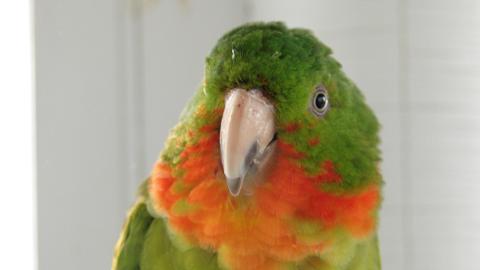 |
| Red Throated Conure - Photo by crazyanimal |
Here is a guide for its care and health that will help you enjoy a long and wonderful life together.
Diet
The Red-Throated Conure will thrive on fresh organic fruits and vegetables. Supplement this with a high-quality pellet mix. Table food is also good including eggs, pasta, bread, crackers. Nuts make an excellent treat when given occasionally.
Don’t forget to vary their diets to keep their interest high. And try to make their food as visually appealing as possible by mixing different colors and textures.
One of the most nutritious food sources is sprouted seeds. They are low in fat as they sprout and offer a different set of nutrients daily as they continue to grow. They are truly a food that keeps on giving. You can buy seeds that are already sprouted, or you can opt to do it yourself. But they are a wonderful investment in the health of your Conure.
Avoid avocado, peanuts, caffeine, chocolate, rhubarb and foods that are high in sugar and salt. These can prove to be fatal.
Living Quarters
The bigger the cage, the happier your Red Throated beauty will be. The cage should be large enough for your bird to spread its wings fully in any direction that it faces. A variety of horizontal perches at different levels will allow for climbing, but they must not cramp your Conure’s ability to spread its wings inside the cage.
They also need to spend several hours a day outside the cage. Providing your bird with play areas and perches outside the cage in an area that is bird safe is an excellent way to keep your bird fit, engaged, socialized, and healthy.
Human Interaction
Making a happy home for this parrot means dedicating several hours of your day each day to interact with your bird. This can include talking, petting, training, or just hanging out together as you read, pay bills, watch TV, or work on your laptop.
Scheduling this time every day will increase the level of trust between bird and owner and will help your bird remain tame and relaxed around you and other family members.
Because they are members of a flock in the wild, they need and expect this social interaction. By spending this time with your bird, you are more likely to avoid behavioral issues such as aggression, feather plucking, and screaming.
Because they are members of a flock in the wild, they need and expect this social interaction. By spending this time with your bird, you are more likely to avoid behavioral issues such as aggression, feather plucking, and screaming.
If you are unable to dedicate at least this amount of time with your Conure, choose another bird as its companion, or rethink your choice of bird.
Disease Prevention
Red Throated Conures are subject to a number of diseases. And even though there is no guarantee, there are many things that you can do to lessen the chance that disease and infection will cut your Red Throated Conure‘s life short.
Schedule an appointment at least every 6 months with an avian vet. Remove fresh food from the cage after an hour to reduce the chance of your bird ingesting mold and mildew that has grown on the food. Clean the cage daily to eliminate small pieces of dried droppings from becoming an airborne and potentially spreading disease.
Filter your bird’s air to keep its air passages clear by removing a large number of airborne pollutants that are present with a bird in captivity. Filtering the air continuously will help your Red Throated Conure avoid respiratory infections that can be so deadly.
Author: Debbie Davis - Source: GoArticles.com
|

